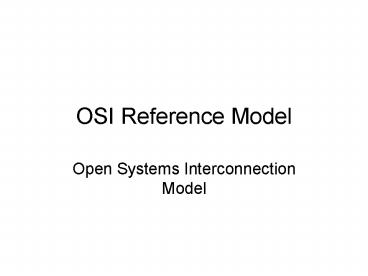OSI Reference Model PowerPoint PPT Presentation
1 / 19
Title: OSI Reference Model
1
OSI Reference Model
- Open Systems Interconnection Model
2
The Layers
- (7) Application
- (6) Presentation
- (5) Session
- (4) Transport
- (3) Network
- (2) Data Link
- (1) Physical
3
Mnemonic
- All People Seem To Need Digital Pizza
- Make your own!
4
Application Layer
- Closest to user
- Communicates with user applications and selects
appropriate network applications for those user
applications - Identifies and establishes availability of
application resources in order to synch apps,
negotiate error recovery, and provide data
integrity. - Ex Email, WWW, FTP, Gopher, MS Word, Telnet
5
Presentation Layer
- Ensures that information received from the
Application layer is readable by the Application
layer of the destination peer - Operations such as encryption, decryption,
compression, and decompression are part of this
layer - Ex ASCII, EBCDIC, MIDI, MPEG, QuickTime, PICT,
TIFF, GIF, JPEG
6
Session Layer
- Establishes, manages, and terminates sessions
between applications - A session consists of a dialogue between
Presentation layers on two or more systems - Ex Network Filing System (NFS), SQL, RPC
7
Transport Layer
- Segments upper-layer application data
- Establishes end-to-end connection
- Sends segments from one host to another
- Ensures reliable data transport
- Key word associated with the Transport layer
segment
8
Transport Layer Flow Control
- Buffering each system has a certain amount of
memory available for buffering information - Multiplexing consists of interweaving packets
from different segments and transmitting them. - Parallelization if the upper layers require
faster service than a channel can provide, the
Transport may combine channels
9
Connection-Oriented
- Transport layer involves reliable transport of
segments - Sends acks for each segment
- Retransmits any segments not acknowledged by
receiving system - Discard any duplicate segments
- Re-orders segments
- Provides congestion avoidance control
10
Connection vs. Connectionless
- Telephone vs. Post Office
- Connectionless Protocol Ex UDP
11
Transport Layer Examples
- TCP, NBP, SPX
12
Network Layer
- Primary purpose is to determine the best path
from one network to another and to route
messages in that direction - The process of routing includes path
determination and packet switching - Creates packets from segments
- Ex Border Gateway Protocol (BGP), Open Shortest
Path First (OSPF, Routing Information Protocol
(RIP)
13
Data Link Layer
- Responsible for translating messages into
frames - Switches bridges
- Divided into two sublayers
- The LLC (Logical Link Control)
- The MAC (Media Access Control)
14
Data Link Layer (LLC Sublayer)
- Allows upper layers to perform independently of
the LAN/WAN protocol or physical media - Performs flow control for upper-layer protocols
- Performs sequences of frames
15
DLL (Media Access Control)
- Maintains the physical address of a device
- The physical address is also referred to as the
MAC address - MAC address is a 48-bit address expressed as 12
hexadecimal digits - First six digits comprise manufacturer
- Last six digits assigned by the manufacturer
- Ex FF34.2345.12AB
16
Data Link Layer Examples
- Frame Relay Link Access Procedure, Balanced
(LAPB) Synchronious Data Link Control (SDLC)
Point-to-Point Protocol (PPP) - Device Bridge
17
Physical Layer
- Performs the mechanical and electrical functions
of the OSI model - Specifies the conversion of 1s and 0s into an
electrical current or pulse of light - Transmission of binary data over a communications
network - Ex Ethernet, FDDI, Token Ring
- Device Repeater
18
Encapsulation
- Protocol stack starts at Application Layer
(PDUs) - Essential to understanding how the OSI model
operates - Encapsulation
- De-encapsulation
19
Summary
- OSI
- ISO

